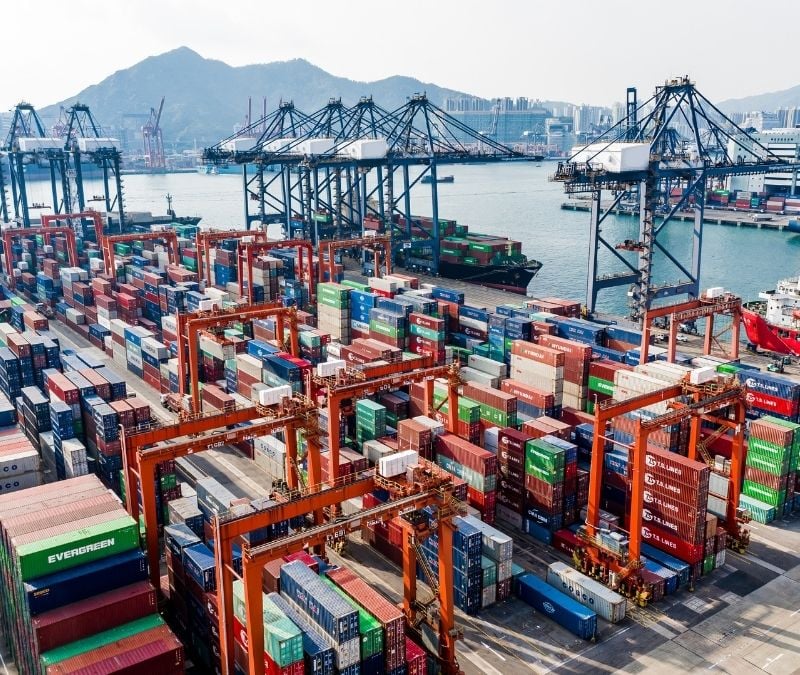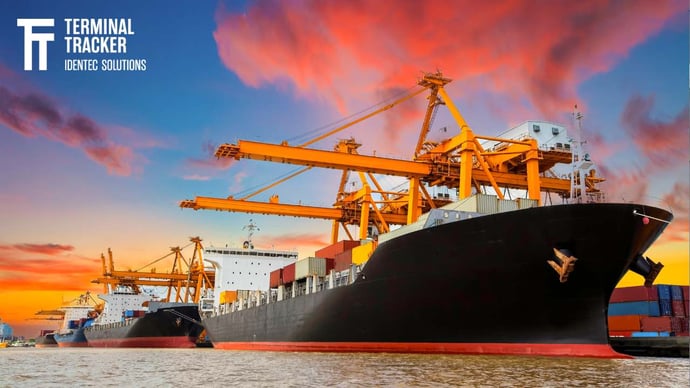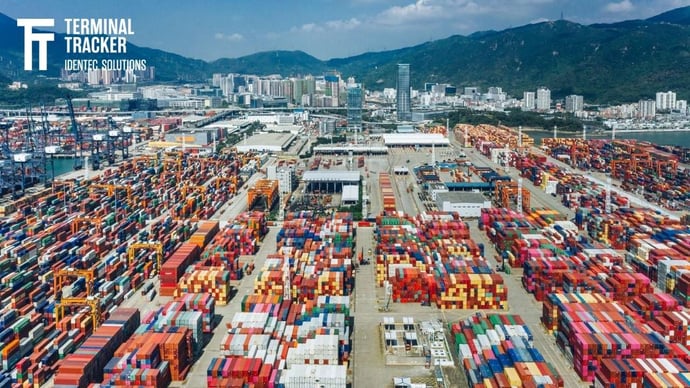Unreported Container Damage: How to achieve fewer claims in Container Terminals
| Written by Mark Buzinkay
If you want to learn how to get rid of unreported damages, turn data into insights and operate your container terminal to its fullest potential.

No video selected
Select a video type in the sidebar.
Container terminals operate on a 24/7 basis, so the demand for availability is exceptionally high (read more about container terminal planning). In addition, container terminals are inherently associated with a potential safety risk, with vehicles and heavy equipment operating close and under time constraints. Collisions are not only dangerous but also associated with high damage claims.
Fabiano, Curro et al. point out that the increase in container-ships traffic and, consequently, the drastic change in port infrastructure involved a rapid modification also in the work organization, leading to a decrease of total workers (e.g. in the port of Genova from 1980 to 2010: from 5783 to nearly 1000 employees) and an increase of low experience workers from 28% to 74% in the same port and time. The latter fact caused an increase in the risk for occupational injuries, from 13.0 to 29.7 on an accident index, mostly because of accidents due to transport vehicles (1).
Why damaged containers are a problem
Damaged containers can pose significant challenges to container terminal operations, impacting the shipment process's safety, efficiency, and sustainability. Accuracy and efficiency are vital in container terminal operations, and any type of issue with cargo can impact the smooth running of the entire process.
The Impact of Damaged Containers
A damaged container can affect every stakeholder in the supply chain, from manufacturers and shippers to port authorities and terminal operators. When goods are damaged during transit, manufacturers and shippers can suffer substantial financial losses.
According to Container xChange, even small damage to a container can cause a 2-5% reduction in its value, resulting in a significant loss for the owner. Furthermore, damaged containers can also affect the safety of workers within the terminal and during transit, leading to the possibility of injury or even death.
The Need for Safety
Safety is a top priority for container terminal operations. Containers are often stacked up to six high, and if any container is damaged, it can lead to a potential collapse, causing injury and damage to the cargo. Therefore, the safe handling of containers during terminal operations is paramount to ensure that everyone involved in the process is safe.
The Challenge of Reporting
Another challenge of damaged containers in terminal operations is the process of reporting. Operators often battle with identifying and reporting damaged containers, leading to missed opportunities for repair and maintenance. Experts state that container damage can often go unnoticed due to inadequate or unreported container damage claims. With inaccurate or ineffective reporting processes, the damaged containers can remain active in the supply chain, leading to increased risks and costs down the line.
Sustainability Concerns
Sustainability is another issue with damaged containers in terminal operations. Damaged containers can help to identify the root cause for the damage and, therefore, help to improve the safety of operations. Every damaged container is causing unnecessary resource waste. If a damaged container cannot be repaired, it is often disposed of, adding to the waste generated by the shipping industry. To maintain sustainable and environmentally conscious operations, avoiding incidents that lead to damaged containers is essential to reduce waste and minimize the overall carbon footprint of the container terminal operations.
Container damage is a worldwide issue
As the terminal is obligated to keep the cargo under their care in the same good order and condition in which it was in upon receiving, they are aware of the potential costs inflicted by damaged goods. Damaged containers are unseaworthy and must be repaired, and damaged goods must be replaced or paid for.
As we all strive for a safe workplace and environment. We apply rules, standards, and processes to improve and establish a safety culture to raise awareness and eliminate sources of incidents.
Unfortunately, many container terminals still suffer from damaged containers and assets. It makes it worse when the damage is unreported – sometimes, there are dangerous situations with a lucky end, most of the time. Eventually, it will disrupt container terminal operations because unreported damages will materialise when you least expect them: A machine's sudden breakdown, an unseaworthy container, a broken power cable to a reefer – incidents of potentially significant effects for the operations planner and the ship's schedule.
One reason for sudden disruptions is unreported incidents. In this article, we are not discussing why the workforce or parts of it won't report damages; on the contrary, we are looking into ways to learn about unreported damages, investigate raised claims, and contain the damage before it worsens. In addition, we want to raise awareness that drivers must report every incident.
With Terminal Tracker, sudden disruptions can be avoided. Here is how…
Causes for Damaged Containers in Ports
When it comes to container terminal operations, damaged containers are a significant concern, and there are several causes for damage. Here are some common causes of damaged containers in ports:
Improper loading and unloading
One of the most common causes of container damage is improper loading and unloading. Containers may be mishandled during this process, causing damage to their structure and contents. Improper loading can include overloading the container, uneven weight distribution, and incorrect stacking.
Transport accidents
Truck drivers often work long hours, leading to fatigue-induced accidents. In addition, drivers in terminal yards must navigate through tight spaces and other traffic, making it difficult for drivers to see pedestrians, other vehicles, or obstacles in their path. This can result in collisions.
Natural disasters and bad weather
Natural disasters such as hurricanes, earthquakes, and tsunamis can pose a significant threat to container terminals and cause significant damage to containers. Harsh weather conditions, such as storms and strong winds, can also cause damage to containers during transit and in port.
Wear and tear, manufacturing defects
Containers have a lifespan of about 10 to 15 years and are exposed to long periods of heavy use and harsh conditions, resulting in wear and tear over time. This can include damages to the container's structure, such as dents, scratches, and rust.
Containers are created in large batches, making them susceptible to defects such as weak welds, punctures, and cracks that may compromise the container's integrity.
Inadequate maintenance
Poor maintenance and lack of regular inspections of the containers can also lead to damage. A lack of maintenance can cause the container to deteriorate and weaken, making it more susceptible to damage during transit.
Yang, Ding et al. suggest that there are seven core risk factors that cause container damage in container terminals: individual experience, operation safety protocols, implementation of safety education, training and assessment of operation skills, personnel safety equipment conditions, establishment of a culture that values safety, and delegation of work (2).
Interested in more? Read our post about container damage codes!

Imagine: There is data
Tracking unreported damages can be pretty challenging; reviewing, collecting, and analysing historical data from various sources is labour-intensive, time-consuming - and prone to errors. Often made impossible due to the lack of available and accurate data (learn more about container yard operations here).
To investigate unreported damages, you need objective, rich data. With a solution like Terminal Tracker that interacts with your TOS, you get the following:
- Hassle-free drivers' access: Driver's credentials are stored and accessible 100% of the time to ensure only authorised personnel access equipment. There are no delays with logging in or out.
- Driver identification: Drivers are automatically logged in/out and reported to the Terminal Operating System. Therefore, you have 100% traceability, increased responsibility, and accountability.
- Shock detection: Each vehicle has a shock detection device that produces immediate feedback in response to excessive driving behaviours such as harsh acceleration, sudden braking, fast cornering, or a potential collision.
- Historical data: Historical data such as location, shock measurements, machine, driver's name, time are all available on a historical map. This makes it easier to track and identify damages within a minute.
- Education: When it comes to workforce education, the best programs have real-life examples. It is imperative to share accurate and easily understandable data with your workforce. Instead of long boring presentations, it is much more valuable to create an environment where you can discuss specific topics that impact their work-life and safety with the crew.
For example, showing the data of "shock alarms/events" to the drivers and discussing the root cause of dangerous events has a way greater impact on their working behaviour than punishing them without explanation. Often, the operator might not even be aware of the danger they put themselves in, and articulate phrases like "We have always done it this way…", "I didn't realise…" or "No one ever told me this…". This is a golden opportunity to educate with data.
Employees must be given a chance to contribute to the cause by accepting responsibility and accountability for their actions. This can only be achieved if they are treated with trust and respect. Accurate data gives us credibility and makes it easier to initiate changes.
By involving your employees in health and safety briefings and discussions, you will ensure their well-being and the functioning of your organisation. Still, you will also be saving a lot of money in the process. This is because unreported damages will decrease with time.
Terminal Tracker turns data into insights
The efficiency of terminal operations depends on whether supply and demand can be adequately planned and handled (learn more about challenges of port automation). A big part of this process is asset management and scheduling. It relies on accurate and up-to-date information on all your assets. This can be almost impossible if unscheduled breakdowns or damages get out of control.
If you want to learn how to get rid of unreported damages, find out more about the capabilities of Terminal Tracker' Shock Management module. Turn data into insights and optimize your container terminal to its fullest potential - with Terminal Tracker.
FAQs
What are the consequences of damaged containers in ports?
The problems caused by damaged containers can have a ripple effect on the companies that use the ports and the supply chain, including:
- Loss of revenue: When goods are damaged during transit due to damaged containers, it can result in a loss of profits for the companies shipping the goods.
- Delays in delivery: If damaged containers cause delays or disruptions to port operations, this can lead to delays in the delivery of goods and potential penalties for late deliveries.
- Reputation damage: Damaged containers could harm the reputation of companies and the ports they use, which can result in the loss of future business.
How are port authorities affected by damaged containers?
Damaged containers create various problems for port authorities, including:
- Safety concerns: Damaged containers can pose a safety risk to employees, cargo, and equipment within ports.
- Financial losses: Port authorities may need to replace damaged containers or pay for repairs, resulting in additional costs.
- Disruptions to operations: If there are damaged containers on a vessel waiting to be unloaded, this can delay the entire operation and lead to congestion within the port.
Research our extensive resources about port automation here...
Glossary
Shock management modules are designed to detect, report, and respond to significant impact events during container handling. They use sensors to monitor shocks and vibrations, alerting operators to potential damage in real-time. The modules can trigger immediate actions, such as shutting down equipment, and provide data for analysis to improve handling procedures and reduce container damage incidents. (3)
Unseaworthy refers to a container that is not reasonably fit for its intended purpose of safely transporting cargo. This can include structural defects, rust, holes, cracks, or improper maintenance that could lead to cargo damage. An unseaworthy container may have pre-existing conditions such as bent door hinges, dents, or inadequate waterproofing. (4)
Sources:
(1) Bruno Fabiano, Fabio Currò, Andrea P. Reverberi, Renato Pastorino: Port safety and the container revolution: A statistical study on human factor and occupational accidents over the long period. In: Safety Science, Volume 48, Issue 8, 2010, Pages 980-990, ISSN 0925-7535, https://doi.org/10.1016/j.ssci.2009.08.007
(2) Yang Y-L, Ding J-F, Chiu C-C, Shyu W-H, Tseng W-J, Chou M-T. Core risk factors influencing safe handling operations for container terminals at Kaohsiung port. Proceedings of the Institution of Mechanical Engineers, Part M: Journal of Engineering for the Maritime Environment. 2016;230(2):444-453. doi:10.1177/1475090214563859
(3) Maritime Law by Yvonne Baatz, Informa Law from Routledge, 2021
(4) The Handbook of Logistics and Distribution Management by Alan Rushton, Phil Croucher, and Peter Baker, Kogan Page, 2022
Note: This article was updated on the 25th of January 2025

Author
Mark Buzinkay, Head of Marketing
Mark Buzinkay holds a PhD in Virtual Anthropology, a Master in Business Administration (Telecommunications Mgmt), a Master of Science in Information Management and a Master of Arts in History, Sociology and Philosophy. Mark spent most of his professional career developing and creating business ideas - from a marketing, organisational and process point of view. He is fascinated by the digital transformation of industries, especially manufacturing and logistics. Mark writes mainly about Industry 4.0, maritime logistics, process and change management, innovations onshore and offshore, and the digital transformation in general.
Related Articles
Related Product





